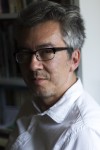Star Wars meets poetry in one of Brian Stefans’ electronic projects.
The poem, which summarizes each episode of the saga, flashes on a screen letter by letter, accompanied by typewriter sounds in the background.
Stefans, an English professor, tries to find innovative ways to combine programming with art to create novel forms of poetry and other writing. Stefans calls his work electronic writing – literature made for electronic mediums, such as computers and smartphones.
He is currently working on “Word Toys: Poetry and Technics,” a book that discusses the intersection between technology and poetry, scheduled for release in July.
Electronic writing began with text-based games that prompt users of the game to follow a story by typing on-screen phrases provided by on-screen instructions.
“It doesn’t have a very tight definition, but I usually just say that it is work that explored the intersection between computer technology and text,” Stefans said.
Stefans started working with electronic writing in the late ’90s, during the outset of the internet. Although he was already an established poet, he’d had an interest in coding and computing since the age of 10, Stefans said.
“There was nothing in the computer world at the time, in my mind, that had anything to do with text or art,” Stefans said. “When the internet hit, it (suddenly) became an exciting thing, as I could make these works that involved graphic design.”
Stefans cites the French writing group Oulipo as a key inspiration for his work. Within the club, mathematicians give writers extreme constraints, such as restrictions on using certain letters or syllables, forcing them to write outside of their comfort zones. In doing this, the group meshed the world of mathematics and art.
Stefans achieves the same blend of worlds through his electronic writing pieces, acting as both the scientist and artist and forcing himself into new boundaries of computing and art.
Some of Stefans’ first electronic literature works include an interactive piece called “The Truth Interview (with Kim Rosenfield),” where an interview is framed within a user-friendly webpage with different links to other articles and poems written by Stefans. By making the art an interactive experience, Stefans allows the user to immerse into the world of the art, he said.
Since then, he has continued to explore the intersection of literature and digital media. One poem about a plane crash has words moving around the screen to form different images, while one interactive game has users identify errors in a story as the story progresses.
The interactive game, entitled “Kluge: A Meditation” runs through a 36-paragraph story from one of his own books. Through the project, Stefans tried to bridge the gap between classic and electronic literature to come out with a wholly original product, he said.
Similarly, in his “One Letter At a Time Series,” Stefans has each letter of a poem appear on the screen one-at-a-time, while noises of a typewriter hitting the keys sound in the background.
“The typewriter is important to his work,” said Nick Montfort, a professor of digital media at MIT, and a fellow electronic writer. “He makes a nice link back to writing technologies that were prevalent decades ago.”
Stefans’ most recent electronic literature project, “Scriptors,” features a series of wall projections intended to appear as a live gallery piece. Inspired by artists such as Jean-Michel Basquiat and Cy Twombly, Stefans wanted to do a piece with a messier aesthetic to deliver a guttural feel, he said.
He made his letters look like they were scrawled by a person rather than typed on a computer. The projected letters morph and change into other letters as the exhibit continues – an attempt to display the ambiguity of shape, Stefans said.
“He has always been a playful writer,” said David Jhave Johnston, an assistant professor at the School of Creative Media at the City University of Hong Kong. “He translates that playfulness from the page into all sorts of media.”
